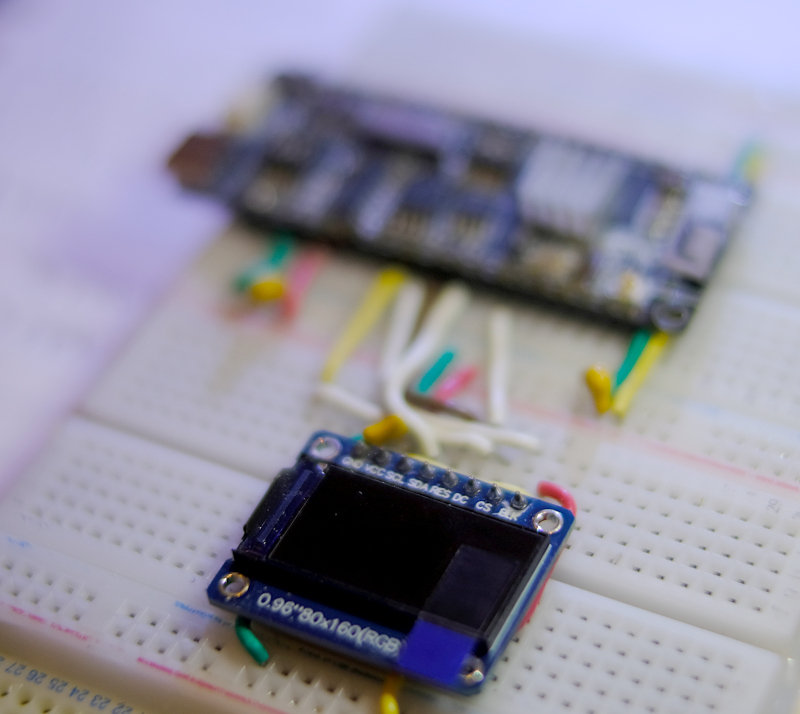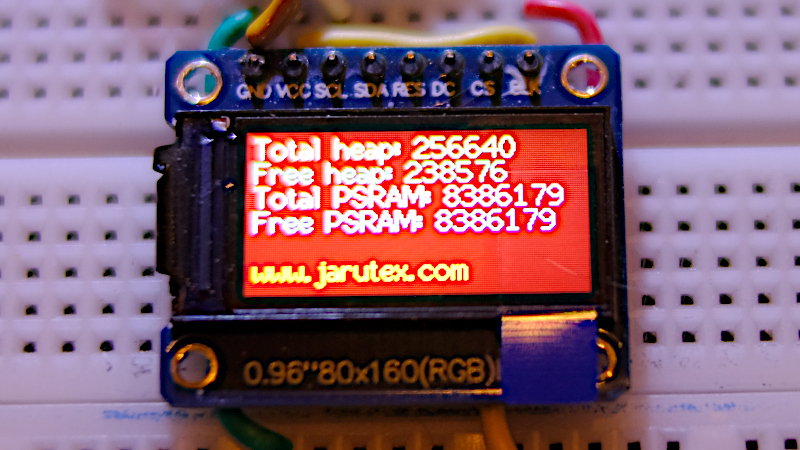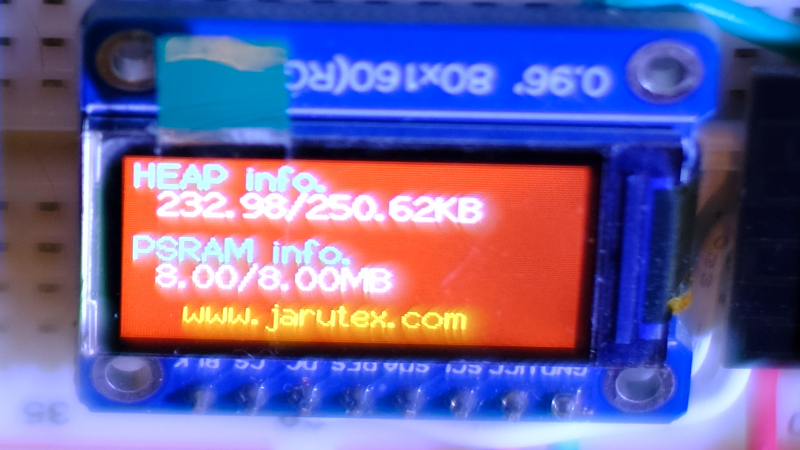This article describes the use of the ST7735s module with the ESP32-S2 microcontroller via the TFT_eSPI library. We have previously discussed its implementation with the ESP32 and STM32F103C microcontrollers, and the chosen TFT module as REDTAB80x160 (added code for GREENTAB80x160 at the end of the article), but you can adjust the settings to other modules, see the User_Setup.h file of the TFT_eSPI library as shown in Figure 1.

Connection
The connection between the REDTAB80x160 st7735s based TFT display module and the ESP32-S2 microcontroller is shown in the following table.
| TFT st7735s REDTAB80x160 | ESP32-S2 |
|---|---|
| Vcc | 3V3 |
| GND | GND |
| MISO | -1 |
| MOSI | 35 |
| SCK | 36 |
| CS | 34 |
| RES | 38 |
| DC | 33 |
TFT_eSPI setting
Modify the TFT_eSPI driver setup run in the User_Setup_Select.h file in the Arduino/libraries/TFT_eSPI folder to run the specific settings set up as follows:
#define ST7735_DRIVER
#define TFT_RGB_ORDER TFT_RGB
#define TFT_WIDTH 80
#define TFT_HEIGHT 160
#define ST7735_REDTAB160x80 // For 160 x 80 display with 24 pixel offset
#define TFT_INVERSION_ON
// ESP32-S2
#define TFT_MISO -1 // 37
#define TFT_MOSI 35
#define TFT_SCLK 36
#define TFT_CS 34 // Chip select control pin
#define TFT_DC 33 // Data Command control pin
#define TFT_RST 38 // Reset pin (could connect to Arduino RESET pin)
#define LOAD_GLCD // Font 1. Original Adafruit 8 pixel font needs ~1820 bytes in FLASH
#define LOAD_FONT2 // Font 2. Small 16 pixel high font, needs ~3534 bytes in FLASH, 96 characters
#define LOAD_FONT4 // Font 4. Medium 26 pixel high font, needs ~5848 bytes in FLASH, 96 characters
#define LOAD_FONT6 // Font 6. Large 48 pixel font, needs ~2666 bytes in FLASH, only characters 1234567890:-.apm
#define LOAD_FONT7 // Font 7. 7 segment 48 pixel font, needs ~2438 bytes in FLASH, only characters 1234567890:-.
#define LOAD_FONT8 // Font 8. Large 75 pixel font needs ~3256 bytes in FLASH, only characters 1234567890:-.
//#define LOAD_FONT8N // Font 8. Alternative to Font 8 above, slightly narrower, so 3 digits fit a 160 pixel TFT
#define LOAD_GFXFF // FreeFonts. Include access to the 48 Adafruit_GFX free fonts FF1 to FF48 and custom fonts
#define SMOOTH_FONT
#define SPI_FREQUENCY 27000000
Example Code
#include <Arduino.h>
#include <SPI.h>
#include <TFT_eSPI.h>
TFT_eSPI tft = TFT_eSPI();
uint16_t colorsBg[] = {
TFT_BLACK, /* 0, 0, 0 */
TFT_NAVY, /* 0, 0, 128 */
TFT_DARKGREEN, /* 0, 128, 0 */
TFT_DARKCYAN, /* 0, 128, 128 */
TFT_MAROON, /* 128, 0, 0 */
TFT_PURPLE, /* 128, 0, 128 */
TFT_OLIVE, /* 128, 128, 0 */
TFT_LIGHTGREY, /* 211, 211, 211 */
TFT_DARKGREY, /* 128, 128, 128 */
TFT_BLUE, /* 0, 0, 255 */
TFT_GREEN, /* 0, 255, 0 */
TFT_CYAN,/* 0, 255, 255 */
TFT_RED,/* 255, 0, 0 */
TFT_MAGENTA,/* 255, 0, 255 */
TFT_YELLOW,/* 255, 255, 0 */
TFT_WHITE ,/* 255, 255, 255 */
TFT_ORANGE,/* 255, 180, 0 */
TFT_GREENYELLOW, /* 180, 255, 0 */
TFT_PINK, /* 255, 192, 203 */ //Lighter pink, was 0xFC9F
TFT_BROWN, /* 150, 75, 0 */
TFT_GOLD, /* 255, 215, 0 */
TFT_SILVER, /* 192, 192, 192 */
TFT_SKYBLUE, /* 135, 206, 235 */
TFT_VIOLET /* 180, 46, 226 */
};
uint16_t colorsFg[] = {
TFT_WHITE - TFT_BLACK, /* 0, 0, 0 */
TFT_WHITE - TFT_NAVY, /* 0, 0, 128 */
TFT_WHITE - TFT_DARKGREEN, /* 0, 128, 0 */
TFT_WHITE - TFT_DARKCYAN, /* 0, 128, 128 */
TFT_WHITE - TFT_MAROON, /* 128, 0, 0 */
TFT_WHITE - TFT_PURPLE, /* 128, 0, 128 */
TFT_WHITE - TFT_OLIVE, /* 128, 128, 0 */
TFT_WHITE - TFT_LIGHTGREY, /* 211, 211, 211 */
// TFT_WHITE - TFT_DARKGREY, /* 128, 128, 128 */
TFT_BLACK,
TFT_WHITE - TFT_BLUE, /* 0, 0, 255 */
TFT_WHITE - TFT_GREEN, /* 0, 255, 0 */
TFT_WHITE - TFT_CYAN, /* 0, 255, 255 */
TFT_WHITE - TFT_RED, /* 255, 0, 0 */
TFT_WHITE - TFT_MAGENTA, /* 255, 0, 255 */
TFT_WHITE - TFT_YELLOW, /* 255, 255, 0 */
TFT_WHITE - TFT_WHITE , /* 255, 255, 255 */
TFT_WHITE - TFT_ORANGE, /* 255, 180, 0 */
TFT_WHITE - TFT_GREENYELLOW, /* 180, 255, 0 */
TFT_WHITE - TFT_PINK, /* 255, 192, 203 */ //Lighter pink, was 0xFC9F
TFT_WHITE - TFT_BROWN, /* 150, 75, 0 */
TFT_WHITE - TFT_GOLD, /* 255, 215, 0 */
TFT_WHITE - TFT_SILVER, /* 192, 192, 192 */
TFT_WHITE - TFT_SKYBLUE, /* 135, 206, 235 */
TFT_WHITE - TFT_VIOLET /* 180, 46, 226 */
};
char colorsName[][16] = {
{"TFT_BLACK"} ,
{"TFT_NAVY"},
{"TFT_DARKGREEN"},
{"TFT_DARKCYAN"},
{"TFT_MAROON"},
{"TFT_PURPLE"},
{"TFT_OLIVE"},
{"TFT_LIGHTGREY"},
{"TFT_DARKGREY"},
{"TFT_BLUE"},
{"TFT_GREEN"},
{"TFT_CYAN"},
{"TFT_RED"},
{"TFT_MAGENTA"},
{"TFT_YELLOW"},
{"TFT_WHITE"},
{"TFT_ORANGE"},
{"TFT_GREENYELLOW"},
{"TFT_PINK"},
{"TFT_BROWN"},
{"TFT_GOLD"},
{"TFT_SILVER"},
{"TFT_SKYBLUE"},
{"TFT_VIOLET"}
};
int colorIdx = 0;
char msg[32];
void setup() {
tft.init();
tft.setRotation(1);
tft.writecommand(TFT_MADCTL);
tft.writedata(TFT_MAD_MV | TFT_MAD_COLOR_ORDER );
}
void loop() {
tft.fillScreen( colorsBg[colorIdx] );
tft.setTextColor( colorsFg[colorIdx] );
tft.drawString( colorsName[colorIdx], 10 , 16, 2 ); // Font No.2
tft.drawString( colorsName[colorIdx], 11 , 16, 2 ); // Font No.2
delay(3000);
colorIdx++;
if (colorIdx == 24) {
colorIdx = 0;
}
}Example 2 shows the memory information of Board ESP32-S2 on the display as shown in Figure 2. The program code is as follows.
#include <Arduino.h>
#include <SPI.h>
#include <TFT_eSPI.h>
TFT_eSPI tft = TFT_eSPI();
void setup() {
char msg[64];
tft.init();
tft.setRotation(1);
tft.writecommand(TFT_MADCTL);
tft.writedata(TFT_MAD_MV | TFT_MAD_COLOR_ORDER );
tft.fillScreen( TFT_MAROON );
sprintf(msg,"Total heap: %d", ESP.getHeapSize());
tft.setTextColor( TFT_WHITE );
tft.drawString( msg, 4 , 0, 2 );
sprintf(msg,"Free heap: %d", ESP.getFreeHeap());
tft.setTextColor( TFT_CYAN );
tft.drawString( msg, 4 , 12, 2 );
sprintf(msg,"Total PSRAM: %d", ESP.getPsramSize());
tft.setTextColor( TFT_WHITE );
tft.drawString( msg, 4 , 24, 2 );
sprintf(msg,"Free PSRAM: %d", ESP.getFreePsram());
tft.setTextColor( TFT_CYAN );
tft.drawString( msg, 4 , 36, 2 );
tft.setTextColor( TFT_YELLOW );
tft.drawString("www.jarutex.com",4,60,2);
}
void loop() {
// put your main code here, to run repeatedly:
}
Code for GREENTAB80X160
User_Setyo.h
#define ST7735_DRIVER
#define TFT_RGB_ORDER TFT_BGR
#define TFT_WIDTH 80
#define TFT_HEIGHT 160
#define ST7735_GREENTAB160x80 // For 160 x 80 display with 24 pixel offset
#define TFT_MISO -1 // 37
#define TFT_MOSI 35
#define TFT_SCLK 36
#define TFT_CS 34 // Chip select control pin
#define TFT_DC 33 // Data Command control pin
#define TFT_RST 38 // Reset pin (could connect to Arduino RESET pin)
#define LOAD_GLCD
#define LOAD_FONT2
#define LOAD_FONT4
#define LOAD_FONT6
#define LOAD_FONT7
#define LOAD_FONT8
#define LOAD_GFXFF
#define SMOOTH_FONT
#define SPI_FREQUENCY 27000000
The example cut writecommand()/writedata in setup() so the code is
#include <Arduino.h>
#include <SPI.h>
#include <TFT_eSPI.h>
TFT_eSPI tft = TFT_eSPI();
void setup() {
char msg[64];
tft.init();
tft.setRotation(1);
tft.fillScreen( TFT_MAROON );
tft.setTextColor( TFT_CYAN );
tft.drawString("HEAP info.",4,0,2);
sprintf(msg,"%.2f/%.2fKB", ESP.getFreeHeap()/1024.0, ESP.getHeapSize()/1024.0);
tft.setTextColor( TFT_WHITE );
tft.drawString( msg, 12 , 12, 2 );
tft.setTextColor( TFT_CYAN );
tft.drawString("PSRAM info.",4,32,2);
sprintf(msg,"%.2f/%.2fMB", ESP.getFreePsram()/1048576.0, ESP.getPsramSize()/1048576.0);
tft.setTextColor( TFT_WHITE );
tft.drawString( msg, 12 , 44, 2 );
tft.setTextColor( TFT_YELLOW );
tft.drawString("www.jarutex.com",22,60,2);
}
void loop() {
}
Conclusion
From this article, you will find that using the TFT module with the ESP32-S2 is the same as with any other microcontroller as the TFT_eSPI library supports connectivity and a set of instructions are available. But having to set the pins to match the work performance is dependent on the choice of microcontroller modules. For example, choosing a model with internal memory only works faster than a model with external SPIRAM because the module is internally communicated not connected to the external bus. But at the cost of a smaller amount of memory, etc. And finally, have fun with programming.
Reference
(C) 2022, By Jarut Busarathid and Danai Jedsadathitikul
Updated 2022-02-26